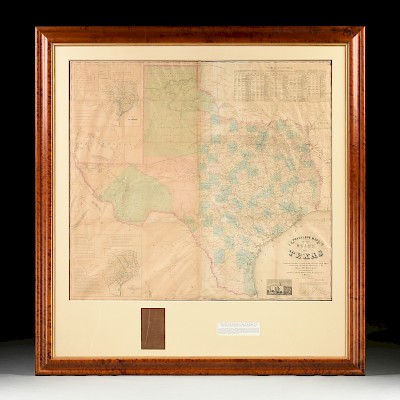AN ANTIQUE MAP, "Systema Solare et Planetarium," NUREMBERG, 18TH CENTURY,
About Seller
6116 Skyline Drive, Suite 1
Houston, TX 77057
United States
Simpson Galleries has been serving Houston’s need for the very best in antique sales venues for more than fifty years. Beginning in 1962, William Simpson started educating himself and others in the art of collecting fine antiques and art objects. Simpson Galleries' commitment to excellence and accur...Read more
Two ways to bid:
- Leave a max absentee bid and the platform will bid on your behalf up to your maximum bid during the live auction.
- Bid live during the auction and your bids will be submitted real-time to the auctioneer.
Bid Increments
| Price | Bid Increment |
|---|---|
| $0 | $25 |
| $500 | $50 |
| $1,000 | $100 |
| $2,000 | $250 |
| $5,000 | $500 |
| $10,000 | $1,000 |
| $20,000 | $2,500 |
| $50,000 | $5,000 |
| $100,000 | $10,000 |
| $200,000 | $25,000 |
About Auction
Sep 22, 2019
Works by Anthony DeYoung, Porfirio Salinas, Robert Wood, Frank Reaugh, Charles Umlauf - and more recent artists Dorothy Hood, Basilios Poulos, Billy Hassell, John Alexander, Ida Kohlmeyer, and George Rodrique. Traditional paintings by American and European masters such as Édouard Cortés, Robert Reid Simpson Galleries online_auctions@simpsongalleries.com
- Lot Description
AN ANTIQUE MAP, "Systema Solare et Planetarium," NUREMBERG, 18TH CENTURY, parcel gilt and hand colored engraving, after work by cartographer Johann Baptist Homann (1664-1724), the present work likely compiled by Johann Doppelmayr (1677-1750) for Atlas Novus Coelestis in quo Mundis Spectabilis, image: 19 1/4" x 22 1/4". Note: The present map, "depicts the state of astronomical knowledge in the early 1700s. In the center is a representation of the Sun-centered heliocentric world introduced by the great Polish astronomer, Nicholas Copernicus. The view here includes descriptions from the Dutch astronomer Christiaan Huygens, complete with sunburst and showing the orbits of the planets and their moons revolving concentrically around the sun. The rest of the universe is shown in the form of the twelve constellations of the zodiac. In the upper left corner, we see representations of the then-known planets along with the Sun. In the upper right corner, we see heavenly clouds and diagrams of other solar systems that were thought to exist around the stars. In the lower left corner, we see a depiction of the solar eclipse of May 12, 1706. In the lower right corner below the illustration of a lunar eclipse, we see representations of three cosmological systems that are being introduced to us by Urania, the goddess of astronomy. Going left to right, we first see the system of the ancient Greek astronomer, Claudius Ptolemy, which is partially obliterated by contemporary astronomical instruments (allegorically implying that modern science has dispatched this view). In this system, the Earth is in the center, followed by the orbits of our Moon, Mercury, Venus, the Sun, Mars, Jupiter, Saturn, and the fixed stars. A hybrid system developed by the Danish astronomer Tycho Brahe is next. In this model, the Earth is in the center and is orbited by the Moon and the Sun. However, Mercury, Venus, Mars, Jupiter, and Saturn orbit the Sun, giving sol some semblance of grandeur. But the fixed stars continue to surround the central Earth. The final model is labeled sic ratione (i.e., according to reason) and is the Copernican system. This labeling and the central dominance of Copernicus' ideas in this print clearly indicate the opinions of Doppelmayr, even though alternative models are included in the corner for historical purposes." "Johann Doppelmayr (1677-1750) was a Professor of Mathematics at the Aegidien Gymnasium in Nuremberg. He wrote on a number of topics, including astronomy, geography, cartography, spherical trigonometry, and scientific instruments, and he collaborated in the production of terrestrial and celestial globes. He was a member of the Royal Society of London and the Berlin and St. Petersburg Academies of Sciences. In the early 1700s, Doppelmayr prepared a number of astronomical and cosmological plates that appeared in several works by cartographer Johann Baptist Homann (1664-1724), who founded a famous cartographic publishing firm that continued through his heirs until 1848. In 1742, these plates were collected and issued as the Atlas Novus Coelestis in quo Mundus Spectabilis?. This atlas had a total of 30 plates, 20 that dealt with various astronomical themes (e.g., cosmological systems of Copernicus and Tycho Brahe, planetary and other bodies in the solar system), and 10 that were constellation maps showing the positions of the stars and the paths of comets." Courtesy: Kanas, Nick, Star Maps: History, Artistry, and Cartography, Springer/Praxis, 2009 and the David Rumsey Map Collection.In very good condition, wear commensurate with age. Simpson Galleries strongly encourages in-person inspection of items by the bidder. Statements by Simpson Galleries regarding the condition of objects are for guidance only and should not be relied upon as statements of fact and do not constitute a representation, warranty, or assumption of liability by Simpson Galleries. All lots offered are sold "AS IS."
Condition
- Shipping Info
-
**SIMPSON GALLERIES, LLC. DOES NOT PROVIDE SHIPPING SERVICES OR SHIPPING QUOTES.** Shipping may be secured through - The UPS Store: store2567@theupsstore.com 281-764-9551, The UPS Store: store3229@theupsstore.com 713-334-8869, PACK-N-SEND: sales@pack-n-send.com 713-266-1450, ACTS Crating and Transportation Services: crating@actsintl.com 713-869-2269, NAVIS Pack & Ship: 17013tx@gonavis.com 713-352-3038, Wintersteen Trucking: wintersteentrucking@yahoo.com 800-253-0617, or the shipper of your choice.
-
- Buyer's Premium



 EUR
EUR CAD
CAD AUD
AUD GBP
GBP MXN
MXN HKD
HKD CNY
CNY MYR
MYR SEK
SEK SGD
SGD CHF
CHF THB
THB




















